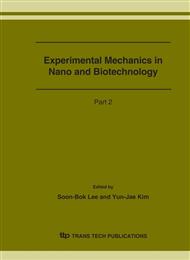p.1317
p.1321
p.1325
p.1331
p.1335
p.1339
p.1343
p.1347
p.1351
A Study on the Development of Reflective Photoelastic Experimental Hybrid Method on the Static Plane Problems of Isotropic Material
Abstract:
The reflective photoelastic experiment can be used more effectively than the transparent of photoelastic experimental method in industrial fields. Therefore the reflective photoelastic experimental hybrid method for the fracture mechanics of isotropic material was developed in this research. Using the reflective photoelastic experimental hybrid method we can obtain stress intensity factors and separate stress components from only the isochromatic fringe patterns. The errors between the experimental values and theoretical values for stress intensity factors are less than 10%. It was verified that the reflective photoelastic experimental hybrid method is very useful for the static plane fracture problems, for the stress intensity factors and for the stress components at the vicinity of the crack-tip in isotropic materials.
Info:
Periodical:
Pages:
1335-1338
Citation:
Online since:
December 2006
Authors:
Price:
Сopyright:
© 2006 Trans Tech Publications Ltd. All Rights Reserved
Share:
Citation:


